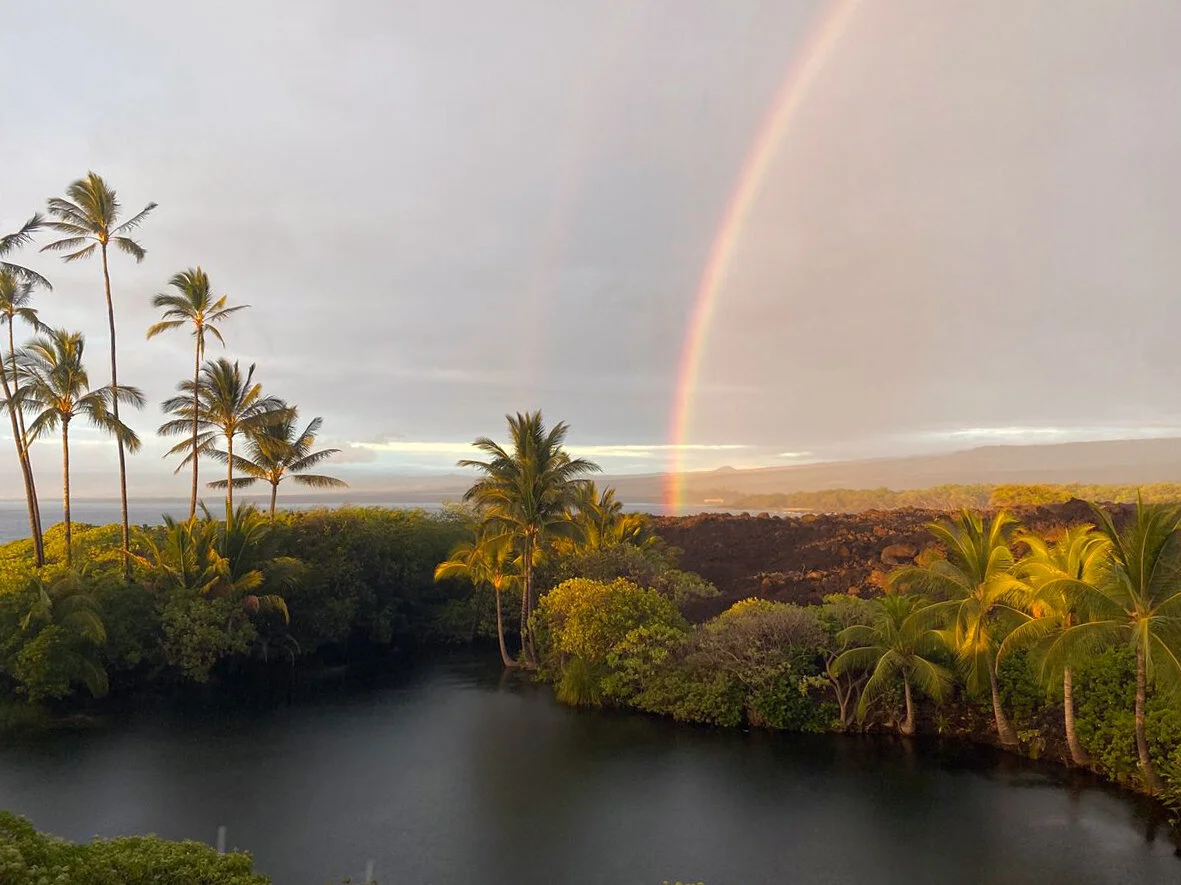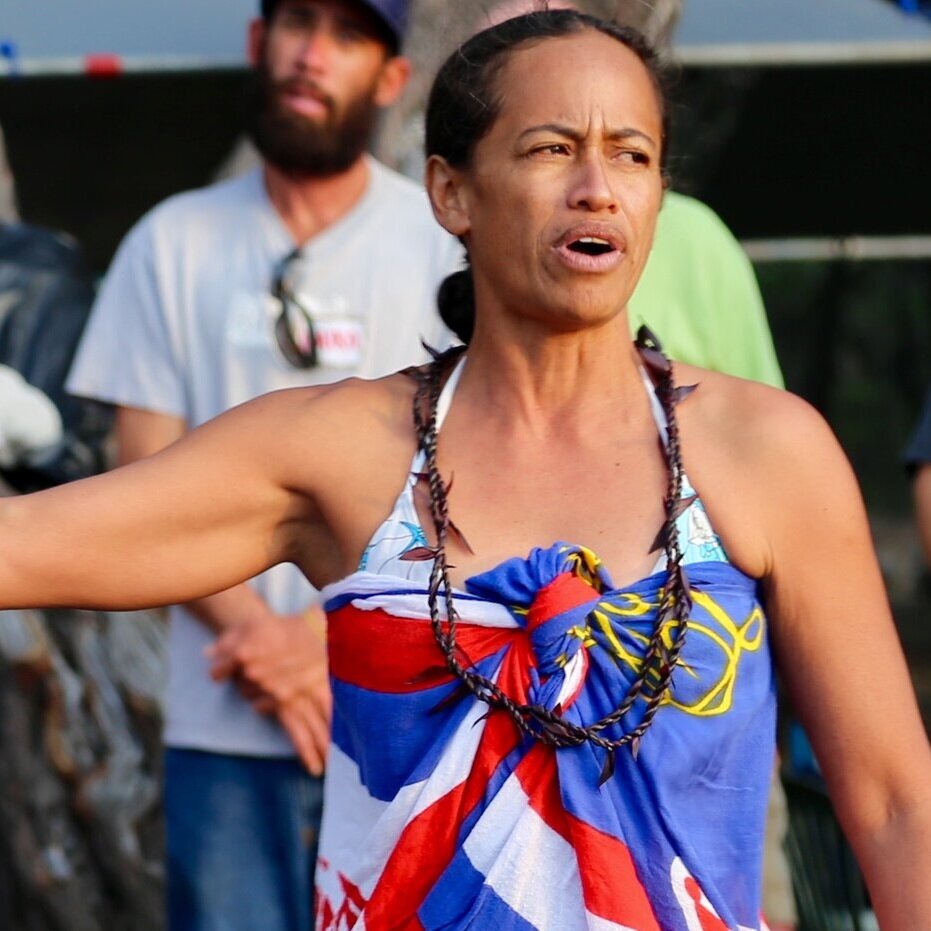On October 30, 2020, Kuʻulei Keakealani and Lehua Kamaka took us down to Kīholo for a morning of kilo and hula. Through the practice of kilo we observe our surroundings and learn more about the cycles of nature. These observations are often incorporated into oli, mele and hula, which serve as repositories for traditional knowledge. In this episode of Aloha Fridays LIVE Kuʻulei shares a hula noho that she composed to depict the elements in the sky which signaled rain was to come for the people of Kona.
Kilo at Kīholo
Join in on our time of kilo as Lehua shares a view from the sparkling pāhoehoe on the shoreline of Kīholo. The pō mahina, or moon phase, is Akua. This morning the ocean has reached a high tide, and is now at kai kū, standing tide, transitioning to low tide. Learn more about kai kū and other terms for the tides in the diagram below. We encourage you to look up the meanings of these terms to learn more about the movement of the ocean. Do you know of other terms that are used to describe the tides where you live?
Listen as Lehua shares about the intertidal species that are so important to feeding our community now, and into the future. Our Hoa ʻĀina team at Hui Aloha Kīholo work to protect and preserve these resources through community outreach at Kīholo.
Māmā Kona i ka wai kau i ka maka o ka ʻōpua
Kuʻulei describes the story of how she came to compose the mele Māmā Kona. While researching at the Bishop Museum the Hen collection she came across an article entitled “Mama Kona i ka wai kau i ka maka o ka opua”, Kona is lightened by the water in the horizon clouds. This article was published in Ka Nūpepa Kūʻokoʻa on March 22, 1923 by an author who goes by the pen name Z.P.K. Kawaikaumaiikamakaokaopua. Jump to timestamp 12:13 to hear her story as Kuʻulei reads the article that tells of the people of Kona who observed the clouds, moon and weather patterns which indicated that rain was in their future.
Māmā Kona: Mele and Hula Noho
Join in at timestamp 25:30 as Kuʻulei teaches the words to the mele, and motions to the hula noho for Māmā Kona.
Names of Rain of Kona
Listen as Kuʻulei shares some names of Kona rains at timestamp 47:37. These Kona rain names were documented by David Malo. Kona or Kona Kū is a very heavy rain that occurs in Kona. Kona Mae is a cold rain. Kona Lani is a little shower. Kona Hea is a cold rain, similar to Kona Mae. Kona Hili Maiʻa is a rain and wind that is found only in the uplands of Kona. We encourage you to learn, speak and share the names of the rains in the lands that you set foot upon.
MAHALO NUI
Mahalo to everyone who came along to Kīholo with us. In this time of social distancing it is an honor to still come together and share the vibrancy of Kīholo with you in safe and responsible ways. Kīholo smiles.
KUʻULEI KEAKEALANI
Educator, cultural practitioner, poet, storyteller, activist, and our Cultural Director at Hui Aloha Kīholo, Kuʻulei wears many hats but wears them all with a strong sense of the history of her ancestors and the responsibility we have to perpetuate Hawaiian culture for future generations.
LEHUA SANDY KAMAKA
Hui Aloha Kīholo operates with a small but dedicated staff and now has a physical presence on the ground, seven days a week, through our Hoa ʻĀina team. Lehua is one of our Hoa ʻĀina. In collaboration with our partners, Hoa ʻĀina, or “friends of the land” monitor and protect natural and cultural resources, engage with and educate visitors, and manage camping. By creating a community of stewards, with visitors, kamaʻāina (locals), partners, and advocates, Kīholo can continue to thrive culturally and environmentally.
Glossary of Hawaiian Terms
Akua - name of the 14th night of the full moon; divine, supernatural, godly
Aloha - love, affection, compassion; to love; to show kindness, mercy, charity, affection
Hoa ʻĀina - tenant, caretaker; literally “friend of the land”
Hualālai - a volcano located on the west side of Hawaiʻi Island which last erupted in 1801
Hui - club, association, society, organization; to join, unite
Hula - a traditional form of dance; to dance the hula; a song or chant used for the hula
Hula noho- a sitting hula
Kai kū - a standing sea
Kīholo - coastal embayment in the ahupuaʻa of Puʻuwaʻawaʻa; large wood fishhook, as used for sharks and large fish; large fish net about 20 fathoms long, held by a canoe at each end; long ti-leaf food package, more commonly called holo ʻai
Kilo - to watch closely, spy, examine, look around, observe, forecast
Kona - the name of two districts on Hawaiʻi Island (North and South Kona); leeward sides of the Hawaiian islands
Mele - a song, chant, poem; to sing or chant
Oli - a chant
Pāhoehoe - a smooth type of lava
Pō mahina - phase of the moon
Do you want to look up Hawaiian word? Go to www.wehewehe.org to search the online Hawaiian-English dictionary.
Reference:
Pukui, Mary Kawena, Samuel H. Elbert. Hawaiian Dictionary. University of Hawaiʻi Press. 1986. Honolulu. <www.wehewehe.org> Accessed April 13, 2020.






